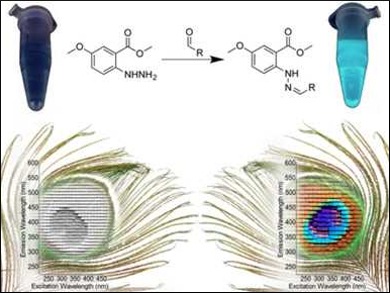Aldehydes occur in “normal” biochemistry, but during disease or injury, pathology-specific and toxic aldehydes can also form. Thus, knowing the precise aldehydes present, in addition to the total aldehyde concentration, could allow the use of aldehydes as early diagnostic biomarkers of diseases.
Adam Shuhendler and colleagues, University of Ottawa, Canada, have developed a fluorogenic probe that rapidly reacts with aldehydes in physiological solutions and provides an optical fingerprint. These fingerprints are fluorescent spectra in the form of excitation-emission matrices (example pictured bottom right); they are specific to the individual bound aldehyde. The probe is an N‐aminoanthranilic methyl ester (pictured top) which rapidly reacts with aldehydes to form hydrazones.
The team developed data reduction and pattern-matching algorithms, which can provide an identification of the bound aldehyde biomarker from its fingerprint. The development of a fluorescent probe which can determine both total aldehyde levels and identify the bound species lays the groundwork for low-cost, rapid, and simple point-of-care diagnostics.
- Fingerprinting Biogenic Aldehydes through Pattern Recognition Analyses of Excitation-Emission Matrices,
Caitlin Lazurko, Ivana Radonjic, Mojmír Suchý, George Liu, Anne-Gaëlle Rolland-Lagan, Adam Shuhendler,
ChemBioChem 2018.
https://doi.org/10.1002/cbic.201800427



